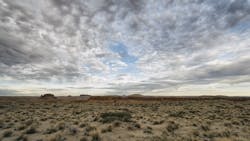Federal Lands as a Solution to the Housing Affordability Crisis
This article first appeared in the May/June 2025 issue of Pro Builder.
In March, Secretary of Housing and Urban Development Scott Turner and Secretary of the Interior Doug Burgum announced the creation of a Joint Task Force on Federal Land for Housing. Their plan is to make federal lands available for new residential construction, thereby increasing housing supply and decreasing costs for millions of Americans.
The idea has gained traction among some Republican lawmakers and conservative think tanks. It has also drawn interest across the political spectrum in high-cost, land-constrained areas—especially in the western U.S., where most federally owned land is located. During his campaign for the presidency, then-candidate Donald Trump promoted the idea on several occasions.
The U.S. government owns roughly 640 million acres, an area almost 25% bigger than the entire country of Mexico. In fact, government-owned land makes up more than a quarter of U.S. total land area. Most of this land is concentrated in a handful of western states. Federally owned land makes up 80% of the land area of the state of Nevada. More than half of the land in Utah, Idaho, and Oregon is federally owned as well. In contrast, just 0.3% of land in Connecticut is owned by the federal government.
The Link Between Land Availability and Affordable Housing
This matters because an insufficient supply of developable lots is a key driver of the nation’s housing affordability crisis. Nationally, values for lots in 2023 reached an all-time high, according to National Association of Home Builders’ (NAHB) analysis of the U.S. Census Bureau’s Survey of Construction (SOC) data, with a median lot value of $58,000 for single-family detached for-sale homes started that year. NAHB’s builder members list the cost and availability of developed lots as one of their biggest challenges.
These government lands are managed by a few federal agencies, including the Bureau of Land Management (BLM), the U.S. Forest Service, and the National Park Service. BLM lands have emerged as a top contender for housing and development because they are not national parks, national forest lands, or Native American reservation lands. They are often simply vast, undeveloped tracts of land adjacent to high-growth housing markets such as Las Vegas.
NAHB supports the effort to use underutilized, federally owned land for new residential construction. Such development should be well-planned, and the land should be used strategically to promote higher-density communities that expand access to affordable homes.
RELATED:
- Policies That Increase Access to Homeownership
- Passions and Priorities for the Year
- NAHB Develops Land Use Resources for Home Builders and Buyers
Development of Federally Held Lands Still in Early Stages, Details Unclear
While the concept of expanding housing development onto federally held lands is straightforward, practical challenges exist related to infrastructure and resource capacity. Developing these areas will require significant investment in public infrastructure and will increase demand on already strained water resources in many western states.
The federal agencies involved have offered few details about how these plans will move forward. NAHB will be speaking with the agencies regularly and will share new information as the government firms up the arrangements under which such lands will be made available. Check nahb.org for updates.
In their joint announcement, Turner and Burgum said HUD will identify where housing needs are most pressing, and the process will be guided by working with state and local leaders who know their communities best. The Department of the Interior will identify locations that can support homes, taking environmental impact and land-use restrictions into consideration. They noted that overlooked rural and tribal communities will be a focus of this joint agreement.
The two secretaries also said that streamlining the regulatory process will be a cornerstone of the partnership. They noted that building on federal land can be “a nightmare of red tape,” with lengthy environmental reviews, complex transfer protocols, and disjointed agency priorities.
Under their partnership, the Department of the Interior will reduce the red tape associated with land transfers or leases to public housing authorities, nonprofits, and local governments. For its part, HUD will ensure these projects align with affordability goals and development needs.
Converting federal lands into developable lots for new residential construction will not by itself solve the nation’s affordability challenges. But, given the high cost of land as a contributor to the affordability problem, NAHB believes development of some federal lands can be an important step in the right direction.
About the Author

National Association of Home Builders
The National Association of Home Builders (NAHB) is a Washington, D.C.-based trade association representing more than 140,000 members involved in home building, remodeling, multifamily construction, property management, subcontracting, design, housing finance, building product manufacturing, and other aspects of residential and light commercial construction. For more, visit nahb.org. Facebook.com/NAHBhome, Twitter.com/NAHBhome

